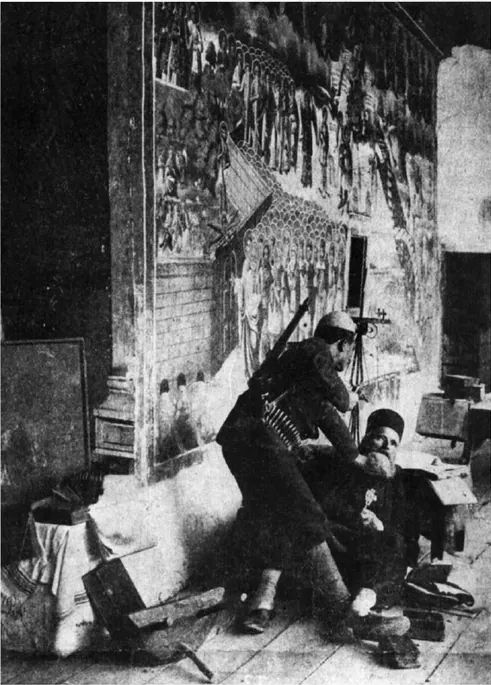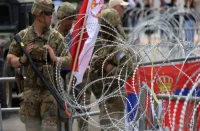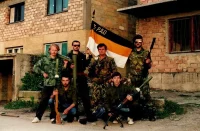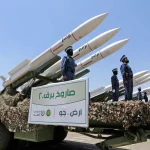Toward the Albanian nation-state
The Albanian people, already faced with major difficulties in the process of building a modern (European) society, were even more affected by the division in the spiritual, political, confessional, and cultural aspects. During the period of the Albanian national movement – Rilindja, 1878−1912 – the leading Albanian national workers tried to constitute Albanians in their entire ethnolinguistic territory based on their common identity, which was primarily considered as linguistic nationality. The crucial reaction of an Albanian leadership to any attempt to dismantle Albanian ethnolinguistic-historical territory from its core was the response to the announced terms of both the Treaty of San Stefano and the Berlin Congress in 1878. Thus, the international community faced the Albanian arguments, which invalidated the proposals concerning the distribution of the “Albanian” lands among its Christian neighbors. The negative attitude of the Great European Powers towards the Albanian Question at the end of the 19th century, served as a catalyst, which strengthened the Albanian (Muslim) domestic forces to struggle for either autonomy within the Ottoman territory or the independence in the case of the collapse of the Ottoman Empire. A national division on the confessional basis was not seriously understood as a significant obstacle for the Albanian unification, at least not from the beginning of the Albanian national movement and, therefore, a single (united) “Albanian” autonomous province within the Ottoman Empire became the major political task of the movement. However, the ethnic Albanians would compose only 44% out of a total population of such “united Albania”.[i]
The interest and perceived goals of the Great European Powers, especially of Austria-Hungary and Italy, in the Albanian geo-strategic and culturally-confessional regions, clashed as these states vied with one another to achieve a position of dominant political-economic influence and power. Austria-Hungary was primarily motivated to counter Serbian and Montenegrin territorial aspirations and the tendencies of the Balkan Orthodox Christians (Bulgarians, Serbs, Greeks, Montenegrins, Romanians) to look to imperial Russia of the Romanovs as their national savior; Russia which had already proclaimed herself as the “Protector of the Orthodox Christians within the Ottoman Empire”. Unified Italy after 1861/1866, found that real possibilities to accomplish its Balkan policy were limited as the Italian Balkan ambitions did not correspond to the Italian economic and political power. France and Great Britain most definitely opposed the Russian desire to take control over the Straits. Thus, both Albania and the Balkans became a microcosmic replica of the larger European political and international relations scene of power competition.[ii]
The ideology and efforts of the Albanian national Rilindja movement in 1878–1912 to unify all Albanian Balkan population who lived in compact masses into a single independent and homogenous state from the ethnic point of view of the Albanians surely jeopardized the idea of territorial integrity of the Serbian, Montenegrin, and Greek nation-states.

There were four main factors, which mostly influenced bilateral relations between Serbia and Montenegro on one side and the Albanians on the other at the turn of the 20th century:
- Historical factor as the Serbs, Montenegrins, and Albanians lived for centuries under the Ottoman governance and had a similar historical destiny.
- Geopolitical factor because all of them belonged to the same geopolitical – Balkan – region and have a long common ethnic line of demarcation.
- Ethnic factor based on the fact that one-third of the Albanian population lived on the territories – Kosovo-Metochia, East Montenegro, and West Macedonia – claimed by the Serbs and Montenegrins to be their ethnohistorical lands and because on the territory of North Albania proper lived Serbo-Montenegrin minority.
- Territorial-political factor since there was a permanent territorial dispute between the Serbo-Montenegrins and Albanians referring to Kosovo-Metochia, East Montenegro, North Albania, and West Macedonia.
Contested Macedonia
The area of geographic-historical Macedonia was the crucial point of disputes among the Balkan states at the end of the 19th century and the beginning of the 20th century. The Macedonian Question became urgent when the Russian diplomacy successfully pressed the Ottoman Government to allow the formation of a separate autonomous Bulgarian Orthodox Church (an Exarchate), extending its jurisdiction over parts of the Ottoman Macedonia populated by the Albanians too. The clash of Balkan nationalisms – Serbian, Albanian, Greek, and Bulgarian – over the territory of Macedonia was a result of several sources: a struggle among the Great European Powers over the territory of the Balkans, a development of young Balkan Christian states and a national awakening of the Christian population and ethnic Albanians within the borders of the Balkan part of the Ottoman Empire.
The policy of the western Great European Powers concerning the Eastern Question (i.e., a destiny of the Ottoman Empire) supported the territorial integrity of the Ottoman Empire favoring the status quo on the Balkans.[iii] On the other hand, the Balkan states and nations had to finish their process of national liberation, which means to dissolute the Ottoman Empire. However, their wish to finish the process of liberation was faced with their nationalism concerning the partitioning of liberated territory from the Ottoman Empire which had two main issues: historical and ethnic backgrounds which were bases for their requirements over Macedonia. In fact, the crucial problem was of fixing the boundaries in ethnic point of view between the Serbs, Albanians, Bulgarians, and Greeks. The Balkan states accepted the leading European principle at the time: one nation – one state, as it was the main principle for the creation of the Italian and the German nation-states in the 1860s and the 1870s. However, the situation on the Balkans was tremendously different since the nations were mixed in consequence of centuries-long migrations.[iv] Because of an inability to fix clear ethnic borders, the Serbian, Greek, Albanian, and Bulgarian nationalisms were backed mainly by their historicism and the real or quasi historic rights on the land.
 The geopolitical background played also a significant role concerning the Macedonian Question. Serbia as a continental state, laying on North Balkans with the state borders on the Danube River, was under strong political, economic and cultural influence from Central Europe. The Serbian policy was completely changed after the Berlin Congress in 1878. Up to the Berlin Congress, the Serbian foreign policy was pointed towards the west; in other words, towards Bosnia-Herzegovina. However, from 1878, the Serbian aspirations concerning territorial enlargement turned to the south where the Ottoman Empire was in fact in the process of internal dissolution and dismemberment. However, here the Serbian aspirations faced a strong challenge by the Albanian, Bulgarian, and Greek nationalisms and vice versa. The Serbian policy toward the Macedonian Question, actually, had two characters: the aggressive and defensive. The aggressive one was expressed in its desire to annex one territory, which had a specific ethnic character. The second one was expressed with its desire to escape political as well as economic encircling by Vienna and Budapest,[v] to provide an exit to the Aegean Sea and to endure a competition by other Balkan states on this area. Such Serbia’s foreign policy was depended on two facts:
The geopolitical background played also a significant role concerning the Macedonian Question. Serbia as a continental state, laying on North Balkans with the state borders on the Danube River, was under strong political, economic and cultural influence from Central Europe. The Serbian policy was completely changed after the Berlin Congress in 1878. Up to the Berlin Congress, the Serbian foreign policy was pointed towards the west; in other words, towards Bosnia-Herzegovina. However, from 1878, the Serbian aspirations concerning territorial enlargement turned to the south where the Ottoman Empire was in fact in the process of internal dissolution and dismemberment. However, here the Serbian aspirations faced a strong challenge by the Albanian, Bulgarian, and Greek nationalisms and vice versa. The Serbian policy toward the Macedonian Question, actually, had two characters: the aggressive and defensive. The aggressive one was expressed in its desire to annex one territory, which had a specific ethnic character. The second one was expressed with its desire to escape political as well as economic encircling by Vienna and Budapest,[v] to provide an exit to the Aegean Sea and to endure a competition by other Balkan states on this area. Such Serbia’s foreign policy was depended on two facts:
- The Adriatic Sea was cut off for Serbia after 1878.
- The strategic importance of the Vardar-Morava valley for Serbia’s economic development.
The similar requirements and desires were present and among other Balkan states and nations. Greece was the Balkan and Mediterranean state. During the period of national revival, the Greek policy concerning territorial enlargement was fluctuated between the north and the south; in other words, between the mainland and the islands. Among the Serbian penetration into Macedonia from the north, Albanian from the west, Greek from the south and Bulgarian penetration from the east the last one was strongest. The whole issue of the Bulgarian foreign policy was all the time pointed to West Balkans particularly towards Macedonia. Serbia and Greece wanted to have common state borders and in this case, the most significant barrier was the Bulgarian desire to annex Macedonia and the Albanian requirement to occupy the western portion of Macedonia and to include it into either autonomous Albanian province within the Ottoman Empire or an independent state of a Greater Albania in the case of the dissolution of the Ottoman state. The Bulgarian and Albanian policies over Macedonia became a deadly danger for Serbia and Greece since in the case of the creation of a Greater Bulgaria and a Greater Albania, Serbia, and Greece would be separated by the common Bulgarian-Albanian border.[vi]
In the last decade of the 19th century, among the Serbo-Greco-Bulgarian-Albanian disputes over Macedonia one additional political factor emerged and took important place and role. It was a Macedonian, its own political movement, the Internal Macedonian Revolutionary Organization (the IMRO, but sponsored by the Bulgarian Government), which put a slogan; “Macedonia for the Macedonians”. The IMRO was fighting either for the autonomous status of Macedonia within the borders of the Ottoman Empire or a free Macedonian state within the community of the Balkan states. However, the IMRO was under strong propaganda from Sofia and financial support by Bulgaria as well as under a great influence of the Bulgarian “vrhovists”.[vii] Clearly, from the Bulgarian point of view, the IMRO from 1903 was a genuinely Bulgarian national organization aimed at the annexation of the three historic-geographic Macedonian regions of the Pirin Mountains, the Vardar valley, and the Aegean sea-coast to the Bulgarian state. The organization received the Bulgarian character and, actually, became an organization under the control of the Bulgarian state.

The Serbian propaganda and official political circles rejected to recognize a Macedonian autonomous status within the Ottoman borders fearing that such kind of autonomous Macedonia will be finally included in the Bulgarian national state. The Serbian propaganda at that time was weakened then Bulgarian one and the idea of a Macedonian autonomy was in direct opposition to the idea of Serbian integral nationalism. Besides, the shadow of an idea of the 1878 San Stefano Bulgaria was present as crucial fear either for the Greek and Albanian or Serbian territorial aspirations on the Balkans. In Belgrade and Athens, likewise among the Albanian political leaders, after 1908 it has existed a strong fear that Bulgaria can incorporate a whole of Macedonia as she did the same with East Rumelia in 1885. In fact, Belgrade and Athens wanted to divide Macedonian territory among themselves and Bulgaria, but not taking into consideration the Albanian national(istic) aspirations.
The struggles over Macedonia between the Balkan states and nations escalated on the level of armed fighting from the very end of the 19th century. In fact, from 1897, when the first armed clash was recorded, the Macedonian issue entered a new stage. The area of Macedonia became from the beginning of the 20th, century territory of bloody struggles among Bulgaria, the Albanians, Serbia, and Greece. In addition to the tremendously complicated situation concerning the Macedonian Question,[viii] from the very beginning of the 20th, century the Austro-Hungarian diplomacy alongside the Russian one was strongly involved in the Macedonian issue. Because of the Austrian great influence into North Albania, the Sanjak of Novi Pazar, as well as Kosovo-Metochia, Serbia, for instance, was afraid that Vienna and Budapest will succeed to get the European mandate for Macedonia and Kosovo-Metochia similarly to the case of Bosnia-Hercegovina in 1878. The Balkan states and nations knew as well as that Rome and Vienna and Budapest made a plan to create an independent Albanian state with the eastern borders till Skopje. In such a way, a territory of Macedonia was under tremendous pressure either by the Balkan states and nations with their nationalistic policies or under the interests of the Great European Powers. For the Balkan Albanians, the real opportunity to realize their national idea about the creation of the independent nation-state came during the Balkan Wars in 1912 due to the combination of two focal factors:
- The disappearance of the Ottoman power almost in the whole Balkan Peninsula.
- The crucial support for the realization of the idea by Austria-Hungary.
To be continued
Reposts are welcomed with the reference to ORIENTAL REVIEW.
Endnotes:
[i] Gaćinović R., „Prva Prizrenska Liga kao putokaz političkog nasilja nad Srbima u Staroj Srbiji“, Vojno delo, 3, 2019, 334.
[ii] Carrie A., Diplomatic History of Europe Since the Congress of Vienna, New York, 1958, 40−43.
[iii] About the Eastern Question, see in more details in [Успенски И. Ф., Источно питање, Београд−Подгорица: Службени лист СЦГ−ЦИД, 2003].
[iv] About the Balkan migrations in historical perspective, see in [Цвијић Ј., Метанастазичка кретања, њихови узроци и последице, Београд: СКА, 1922].
[v] About Serbia’s relations with Austria-Hungary at the beginning of the 20th century, see in [Ћоровић В., Односи између Србије и Аустро-Угарске у XX веку, Београд: Библиотека града Београда, 1992].
[vi] See in more detail in [Војводић М., Србија у међународним односима крајем XIX и почетком XX века, Београд: САНУ, 1988, 390−402].
[vii] Историја на македонскиот народ, II, Скопје, 1969, 165−167; История на Бьлгария, София, 1962, 140−144.
[viii] About the Macedonian Question, see more details in [Pettifer J. (ed.), The New Macedonian Question, New York: Palgrave, 2001].














If so, u can freely say that Servia and Greece or Bullgaria were the Great EU powers and not those who in 1878 separeted Albania in peices, exactly to shut serbia’s mouth(black hand), greece’s mouth(irredentists), both rampant in nationalism. Hahahaha! U can see a map of 1720 (51 years before greater servia project) that was important in Albania 1912-13 borders designation. Anyway not the real one as we have disqualification of albanians only of religious reason. This was the fact why greece and servia is recognized before autochthonous population descedant of illyrians. https://archive.org/details/geographyanatomi00ingord/page/n231/mode/2up -Real eyes, realise, real lies. 3xpectant of next part.
Albania did not exist in 1878. The first Nazifascist project of Greater Albania was created in 1878 by the First Prizren League with the aim of ethnic cleansing and genocide on all non Albanians within the borders of megalomanic and imperialistic Greater Albania. The project was realized by Mussolini in WWII with ethnic cleansing of Serbs in Kosovo and resettlement of 300.000 Muslim Albanians from North Albania to Kosovo to occupy Serbian Christian houses.